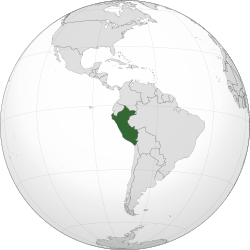Portal:Peru
Introduction
Peru, officially the Republic of Peru, is a country in western South America. It is bordered to the north by Ecuador and Colombia, to the east by Brazil, to the southeast by Bolivia, to the south by Chile, and to the south and west by the Pacific Ocean. Peru is a megadiverse country, with habitats ranging from the arid plains of the Pacific coastal region in the west, to the peaks of the Andes mountains extending from the north to the southeast of the country, to the tropical Amazon basin rainforest in the east with the Amazon River. Peru has a population of over 32 million, and its capital and largest city is Lima. At 1,285,216 km2 (496,225 sq mi), Peru is the 19th largest country in the world, and the third largest in South America. Peruvian territory was home to several cultures during the ancient and medieval periods, and has one of the longest histories of civilization of any country, tracing its heritage back to the 10th millennium BCE Caral–Supe civilization, the earliest civilization in the Americas and considered one of the cradles of civilization. Notable succeeding cultures and civilizations include the Nazca culture, the Wari and Tiwanaku empires, the Kingdom of Cusco, and the Inca Empire, the largest known state in the pre-Columbian Americas. The Spanish Empire conquered the region in the 16th century and Charles V established a viceroyalty with the official name of the Kingdom of Peru that encompassed most of its South American territories, with its capital in Lima. Higher education started in the Americas with the official establishment of the National University of San Marcos in Lima in 1551. Peru's population includes Mestizos, Amerindians, Europeans, Africans and Asians. The main spoken language is Spanish, although a significant number of Peruvians speak Quechuan languages, Aymara, or other Indigenous languages. This mixture of cultural traditions has resulted in a wide diversity of expressions in fields such as art, cuisine, literature, and music. Peru has recently gained international recognition for its vibrant gastronomy, blending Indigenous, Spanish, African, and Asian influences. Lima is now considered a global culinary capital, home to award-winning restaurants like Central and Maido. (Full article...) Entries here consist of Good and Featured articles, which meet a core set of high editorial standards.
 Peru sent a delegation to compete in the 2010 Winter Olympics in Vancouver, British Columbia, Canada from 12 to 28 February 2010. This marked Peru's debut at the Winter Olympics. The Peruvian delegation consisted of three athletes: two alpine skiers—Manfred Oettl Reyes and Ornella Oettl Reyes—and the cross-country skier Roberto Carcelen. The nation's best performance in any event was 67th place in the men's giant slalom alpine skiing event by Manfred Oettl Reyes. (Full article...) Selected image Photo credit: Ericbronder
The main square of Abancay, capital of the Apurímac Region, has several palm trees which have adapted to the city's elevation of 2378 meters above sea level. Most cities in Peru have main squares, which are called Plaza de Armas in Spanish. They are usually surrounded by the principal city buildings such as the town hall or the main church. (more...) Selected battleThe Battle of Angamos (8 October 1879) was an important struggle in the War of the Pacific, where the Peruvian ironclad Huáscar was surrounded and captured by the Chilean Navy. The captain of the ironclad, Peruvian Admiral Miguel Grau, was killed in the combat. After this battle, the Peruvian Navy was unable to prevent the invasion of its territorial sea. The seas were cleared for the invasion of Peru and Bolivia. (more...) In this month
General imagesThe following are images from various Peru-related articles on Wikipedia.
Selected article - Club Universitario de Deportes is a Peruvian sports club based in Lima, which has soccer as its main activity. It also has women's football, volleyball and basketball sections. The football team, popularly known as Universitario, has competed in the top tier of Peruvian football, the Peruvian Primera División (Liga 1), since 1928. They are the most successful team in Peruvian football with 28 titles and have never been relegated. The club was founded in August 1924 under the name Federación Universitaria by students of the National University of San Marcos but was forced to rename it in 1931. The club won its first Peruvian title in 1929, one year after its debut in the first division. The club won its first double in the 1945 and 1946 seasons and won its only treble after conquering the 2000 season. Since then, Universitario has won twenty-seven first-division titles and was the first Peruvian club, and the Pacific, to reach the final of the Copa Libertadores in 1972. Universitario is one of the two most popular teams in Peru. Universitario's youth team is U América FC which currently participates in the Copa Perú. According to the International Federation of Football History and Statistics, an international organization recognized by FIFA, Universitario was the best Peruvian club of the 20th century and the 28th most successful in South America. (Full article...) Did you know (auto-generated) -
CategoriesRelated portalsSelected quote -
Peruvian-born American author Carlos Castaneda
Basic facts & figuresMore did you know...
Peru TopicsRecognized content
Featured articlesFeatured listsGood articles
WikiProjectsThings you can do
New articlesThis list was generated from these rules. Questions and feedback are always welcome! The search is being run daily with the most recent ~14 days of results. Note: Some articles may not be relevant to this project.
Rules | Match log | Results page (for watching) | Last updated: 2025-06-24 23:13 (UTC) Note: The list display can now be customized by each user. See List display personalization for details.
Associated WikimediaThe following Wikimedia Foundation sister projects provide more on this subject:
Discover Wikipedia using portals | |||||||||||||||
















































